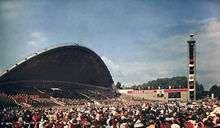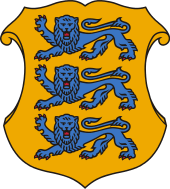Estonian Song Festival
The Estonian Song Festival (in Estonian: laulupidu, Estonian pronunciation: [ˈlɑu.luˈpi.du]) is one of the largest choral events in the world, a Masterpiece of the Oral and Intangible Heritage of Humanity. It is held every five years in July on the Tallinn Song Festival Grounds (Lauluväljak) simultaneously with the Estonian Dance Festival.[1] The joint choir has comprised more than 30,000 singers performing to an audience of 80,000.[1][2]
.jpg)

History
| Song Festival | Year | Place | Choirs | Participants |
|---|---|---|---|---|
| I Song Festival | 1869 | Tartu | 51 | 845 |
| II Song Festival | 1879 | Tartu | 64 | 1,272 |
| III Song Festival | 1880 | Tallinn | 48 | 782 |
| IV Song Festival | 1891 | Tartu | 179 | 2,700 |
| V Song Festival | 1894 | Tartu | 263 | 3,951 |
| VI Song Festival | 1896 | Tallinn | 410 | 5,681 |
| VII Song Festival | 1910 | Tallinn | 527 | 10,000 |
| VIII Song Festival | 1923 | Tallinn | 386 | 10,562 |
| IX Song Festival | 1928 | Tallinn | 436 | 15,049 |
| X Song Festival | 1933 | Tallinn | 500 | 16,500 |
| XI Song Festival | 1938 | Tallinn | 569 | 17,501 |
| XII Song Festival | 1947 | Tallinn | 703 | 25,760 |
| XIII Song Festival | 1950 | Tallinn | 1,106 | 31,907 |
| XIV Song Festival | 1955 | Tallinn | 893 | 30,321 |
| XV Song Festival | 1960 | Tallinn | 875 | 29,273 |
| XVI Song Festival | 1965 | Tallinn | 690 | 25,806 |
| XVII Song Festival | 1969 | Tallinn | 771 | 30,230 |
| XVIII Song Festival | 1975 | Tallinn | 641 | 28,537 |
| XIX Song Festival | 1980 | Tallinn | 627 | 28,969 |
| XX Song Festival | 1985 | Tallinn | 677 | 26,437 |
| XXI Song Festival | 1990 | Tallinn | 690 | 28,922 |
| XXII Song Festival | 1994 | Tallinn | 811 | 25,802 |
| XXIII Song Festival | 1999 | Tallinn | 856 | 24,875 |
| XXIV Song Festival | 2004 | Tallinn | 850 | 22,759 |
| XXV Song Festival | 2009 | Tallinn | 864 | 26,430 |
| XXVI Song Festival | 2014 | Tallinn | 1,046[4] | 33,025[4] |
| XXVII Song Festival | 2019 | Tallinn | 1,020 | 32,302 |
The tradition of the song festival was born along with Estonian national awakening. The first national song festival was held in Tartu in the summer of 1869.[1] One of the organisers of the first song festival was Johann Voldemar Jannsen. In the first three festivals only men's choirs and brass orchestras participated. 822 singers and 56 brass players participated in the first festival. Starting with the fourth festival, mixed choirs were also participating. Starting with the sixth festival in 1896, the festival tradition moved to Tallinn.
Starting from 1947, the Soviet authorities forced foreign songs into the repertoire. Every event was to include the State Anthem of the Estonian SSR, The Internationale, and the State Anthem of the Soviet Union.[1] Because of the inclusion of children's and boys' choirs the total number of participants rose to 25,000 – 30,000 people. The Dance and Gymnastic Festival of the First Estonian Games started in 1934 became predecessors of later National Dance Festivals accompanying the song festival.[5]
In 2019, the number of visitors to the song festival reached its maximum. Nearly 60,000 tickets were sold from the pre-sale for the XXVII song festival "My Arm" concert, and together with the 35,000 singers and musicians participating, a situation has been reached where the pre-sale of tickets was suspended by the decision of the organizers for the safety and security of people.
See also
References
- Estonian Song and Dance Celebrations Estonian Song and Dance Celebration Foundation
- Lauluväljakul oli teisel kontserdil 110 000 inimest (110,000 people in the Song Festival Grounds during the second concert. In Estonian). Delfi
- "Peod aastani 2029" (in Estonian). Laulu- ja Tantsupeo SA. Retrieved 8 July 2014.
- Uudiskirjad Archived 22 November 2015 at the Wayback Machine. Eesti Laulu- ja Tantsupeo SA.
- Dance Festival – Invented Tradition? Archived 10 June 2007 at the Wayback Machine by Marika Plakso. Estonian Institute
External links
| Wikimedia Commons has media related to Estonian Song Celebration. |
- Official web site
- Cultural identity, nationalism and changes in singing traditions by Kristin Kuutma
- The Estonian song festival: a chameleon strategy by Evi Arujärv
- Estonian Punk Song Festival
- To Breathe As One, video about the event
Photos and videos
- QTVR fullscreen panoramas of the Estonian Song Festival
